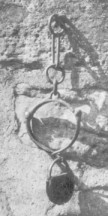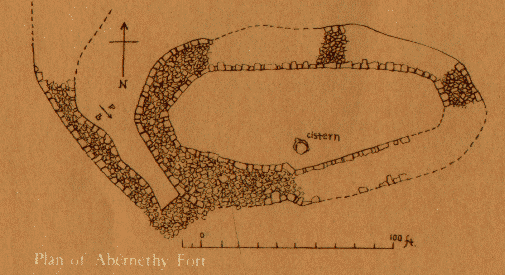|
Historic Outline
The town of Abernethy was once an ancient Pictish capital. It was known as 'Obair Nechtan' to the Highlanders, which means Nechtan's work or stronghold. Nechtan was the name of more than one of the Pictish Kings who were said to be the founders of the town and who selected it as their capital and place of residence. They claimed to be Christians even before the coming of St. Columba and a church was built at Abernethy which became a Monastery and a place of learning through the Dark Ages. The town has a long history of religious involvement, being once the seat of the Bishops of the whole Pictish Kingdom. a centre of the Culdees until 1273 and one of the early seats of the Secession Church in the mid? 18th century. Close by the site of the old monastery is the Round Tower, an early 9th century building. It was used as a belfry and probably as a keep to secure the Monks and their valuables from marauders of the times, the door being situated high off the ground and well suited for defence. Several skeletons, one in a stone coffin, were found buried under the Tower during excavations in the first half of the nineteenth century. It is thought that they were the remains of distinguished early ecclesiastics.  The collar and chain fixed to the outer wall of the tower is known as a Joug and was used to chain miscreants to the building on the schoolmaster's midden as punishment for lesser crimes. 
| Not far from the Tower, the Kirk Wynd leads up to Loanhead Quarry, once worked for road building material, and then on to the Witches Road that was used, as legend has it, by witches and other supernatural forces on their way up to Castle Law. These witches were brought to their end by the Laird of Invernethy who, by subterfuge. tricked them into revealing their names and thus ended their practices. They were burned on the town hill (Abernethy Hill) and their ashes deposited on a level space to the East where the two and twenty hillocks are known as the Witches Graves to this day. This same Laird is the one who, for a bet, carried a silver groat on the toe of his boot all the way down the difficult track from the Law. This track can still be seen today marked by an embankment lined with boulders. It is quite possibly as old as the fort on the Law itself'. On Castle Law, is an ancient Iron Age fort formed by an oval enclosure of' about 136 feet by 51 feet enclosed by a stone wall 18 feet to 25 feet thick.The wall consisted of inner and outer facings of dressed stone infilled with rubble reinforced by horizontal and vertical timbers. Another wall branches out from the main building down to a small loch and marsh which, together with a rock cut cistern within the fort, may have supplied water to the fort's defenders. Below the northern line of defence there is a natural terrace on which can be found the remains of circular Iron Age hut foundations. 
This hill site is important as it has produced several dateable pre-Roman finds:-- a bronze brooch, a polished felstone axe, stone lamps and other fragments pointing to a date of about the 2nd or 3rd century B.C.  A legend of this area relates that when the Scots were fighting the Picts a nurse, in a vain attempt to escape with the Royal heir in a solid gold cradle, threw herself and the child into the Loch and drowned. When the Scots were attempting to recover the gold a fierce tempest blew up and a gaunt figure of a woman appeared to them out of' the Loch. saying:
Below the fort is the Rough Glen which was once part of the route from Strathmiglo to Abernethy. used for the transport of coal and lime. The original stone paving is still in existence beneath the present earth covering. The road then continued to Perth via Hatton, Carey, Culfargey and over the Earn at the old Bridge of' Earn. This, was before it was replaced by the road through Glenfarg that used much of the stone from the fort in its construction. One of the tracks on the hill possibly formed part of the Coronation Road leading, from Falkland Palace via Abernethy. Elcho and by Ferry to Kinfauns and then overhill to Scone. | |||||||||||||||||
| Return to Menu | ||||||||||||||||||